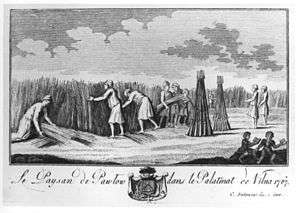Republic of Paulava

| Paulava Republic Rzeczpospolita Pawłowska Paulavos respublika | |
|---|---|
| 1769–1795 | |
| Capital | Merkinė Manor |
| Government | Republic |
| History | |
• Established | 1769 |
• Disestablished | 1795 |
| Area | |
| 30.4 km2 (11.7 sq mi) | |
| Population | |
• | 800 |
| Today part of | Lithuania |
Paulava Republic (Polish: Rzeczpospolita Pawłowska, Lithuanian: Paulavos respublika) was a small self-governing peasant community founded by Paweł Ksawery Brzostowski, a Catholic priest. Located around the Merkinė Manor (also Pavlovo Manor) in the Grand Duchy of Lithuania (present-day Šalčininkai District Municipality, Lithuania), it was a micronation with its own parliament, army, and laws.[1] It had its own constitution which was created before the Constitution of 3 May 1791. The Great Sejm (1788–1792) recognized the republic and approved its statute.[2] It covered an area of 30.4 square kilometres (11.7 sq mi) and had about 800 residents.[1]
Brzostowski implemented various progressive policies – abolished serfdom granting personal freedoms to the peasants, replaced corvée with a land tax paid in cash, established a school and a pharmacy, encouraged more profitable agricultural activities (such as fruit tree gardens or animal husbandry).[1] Brzostowski's revenue from the manor more than doubled. The republic ceased to exist in 1795 when, due to the Third Partition of the Polish–Lithuanian Commonwealth, Brzostowski exchanged the manor with Fryderyk Józef Moszyński for properties in Saxony and Dresden. Moszyński sold the manor to Count de Choiseul-Gouffier in 1799.[2] The new owners tolerated some of the freedoms until Brzostowski's death in 1827. The last freedoms were lost when peasants joined the failed November Uprising in 1830.[1]
References
| Wikimedia Commons has media related to Paweł Ksawery Brzostowski. |
| Wikimedia Commons has media related to Paulava manor. |
- 1 2 3 4 Jasas, Rimantas (2010-06-15). "Paulavos respublika". Visuotinė lietuvių enciklopedija (in Lithuanian). Mokslo ir enciklopedijų leidybos centras.
- 1 2 "Merkinės dvaro sodybos, vad. Pavlovo respublika, fragmentai" (in Lithuanian). Kultūros paveldo departamentas. Retrieved 15 July 2018.